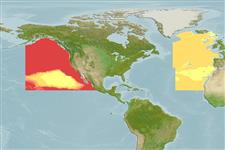Environment: milieu / climate zone / depth range / distribution range
Ecologie
marien bathypelagisch; diepte 400 - 1620 m (Ref. 50610). Deep-water; 66°N - 18°N, 160°W - 5°W
Eastern Atlantic: Madeira Islands. Eastern Pacific: British Columbia, Canada (Ref. 11980). Some records of Maulisia argipalla have been misidentified as Maulisia mauli.
Grootte / Gewicht / Leeftijd
Maturity: Lm ? range ? - ? cm
Max length : 19.5 cm SL mannelijk / geslacht onbekend; (Ref. 96339)
Meso- and benthopelagic at 850-1500 m (Ref. 58302).
Levenscyclus en paargedrag
Maturiteit | Voortplanting | Paaien | Eieren | Fecunditeit | Larven
Quéro, J.-C., T. Matsui, R.H. Rosenblatt and Y.I. Sazonov, 1984. Searsiidae. p. 256-267. In P.J.P. Whitehead, M.-L. Bauchot, J.-C. Hureau, J. Nielsen and E. Tortonese (eds.) Fishes of the north-eastern Atlantic and the Mediterranean. UNESCO, Paris. Vol. 1. (Ref. 6682)
Status op de Rode Lijst van het IUCN (Ref. 130435)
Gevaar voor de mens
Harmless
Gebruik door de mens
Meer informatie
Lokale namenSynoniemenMetabolismePredatorenEcotoxicologieVoortplantingMaturiteitPaaienPaaiaggregatiesFecunditeitEierenOntwikkeling van de eieren
Leeftijd/GrootteGroeiLengte-gewichtLengte-lengteLengtefrequentiesMorfometrieMorfologieLarvenLarvale populatiedynamiekRekruteringAbundantieBRUVS
ReferentiesAquacultuurAquacultuurprofielKweeklijnenGeneticaElectrophoresesErfelijkheidZiektesVerwerkingNutrientsMassaconversie
Tools
Speciale rapporten
Download XML
Internetbronnen
Estimates based on models
Preferred temperature (Ref.
123201): 3.4 - 7.5, mean 5.8 °C (based on 93 cells).
Fylogenetische diversiteitsindex (Ref.
82804): PD
50 = 0.5312 [Uniqueness, from 0.5 = low to 2.0 = high].
Bayesian length-weight: a=0.01122 (0.00514 - 0.02450), b=3.04 (2.87 - 3.21), in cm total length, based on all LWR estimates for this body shape (Ref.
93245).
Trofisch niveau (Ref.
69278): 3.4 ±0.5 se; based on size and trophs of closest relatives
Weerstandsvermogen (Ref.
120179): Gemiddeld, minimale populatieverdubbelingstijd 1,4-4,4 jaar (Assuming tmax>3).
Fishing Vulnerability (Ref.
59153): Low vulnerability (14 of 100).
